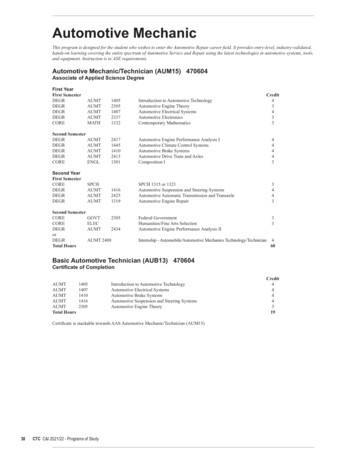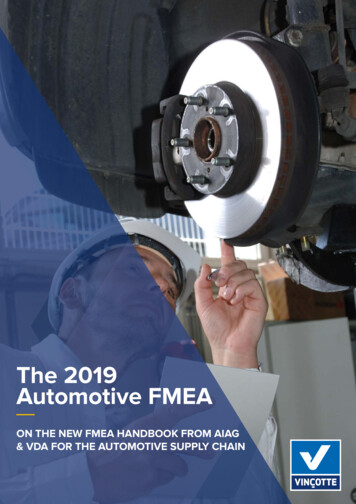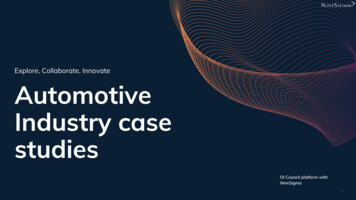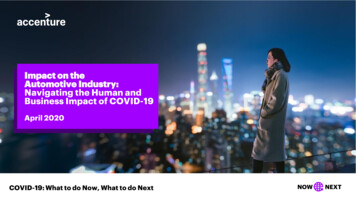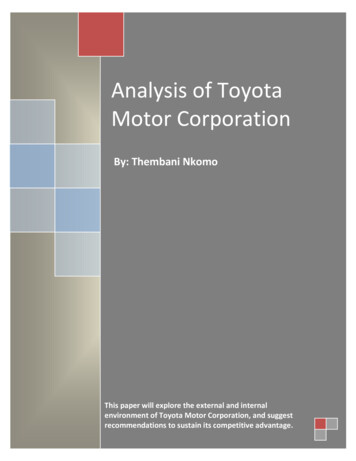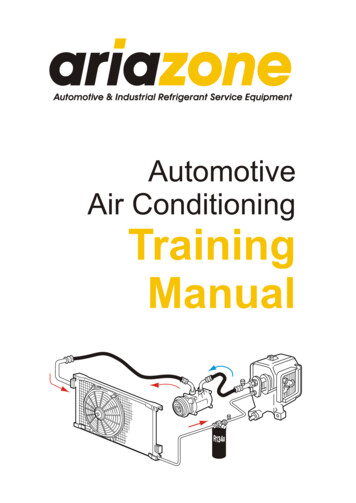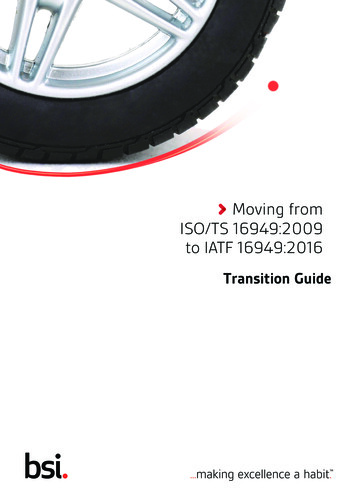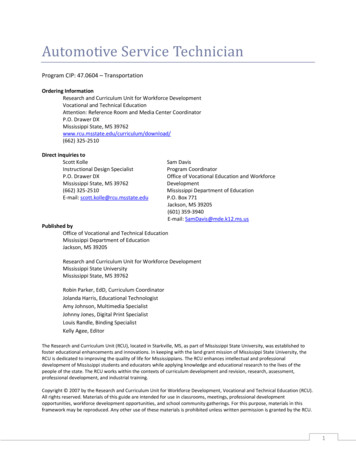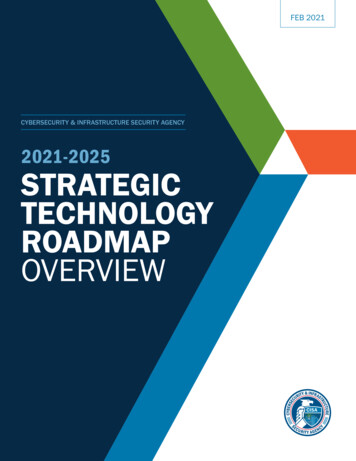
Transcription
The Automotive Industryto 2025 (and beyond)Chris Atkinson, Sc.D.Program DirectorAdvanced Research Projects Agency-Energy2016 EIA Energy ConferenceJuly 11, 2016
ARPA-E Mission1
Evolution of ARPA-E500 39AwardsAnnouncedProgramsTo Date2007Rising Above theGathering StormPublishedAmericaCOMPETES ActSigned32371200972010AmericanRecovery &Reinvestment ActSigned 400 Million(Recovery uthorizationSigned 180 Million 275 Million 251 Million(FY2011)(FY2013)(FY2012)2016Anticipated 280 Million(FY2014) 280 Million(FY2015) 291 Million(FY2016)2
Focused Program PortfolioELECTRICITYGENERATIONALPHAFOCUSSOLAR ADEPTIMPACCTGENSETSREBELSELECTRICAL GRID& TRO2010 - 2012GRID SNETRANGEMOVEENLITENEDSHIELDMONITORTRANSPORTATION& STORAGEMOSAICNEXTCARREFUELTERRA201520163
Energy Consumed by TransportationLight-, medium and heavy-duty vehicles consume 11 million barrels per day oilequivalent, totaling 81% of transportation sector energy consumption, or 23% of the US primary energy usage.
3 Significant Trends in Automotive Transportation5
Trend 1 – Fuel Economy‣ Future fuel economy of the light-duty vehicle fleet will be required to besignificantly higher than today (54.5 mpg CAFE by 2025).‣ Heavy-duty fuel economy regulated by EPA/NHTSA Phase 2 GHG rules.Fuel efficiency improvements will be achieved by vehicle light-weighting, reducingaerodynamic drag and tire rolling losses, engine downsizing, boosting, improvedtransmissions, increased electrification, hybridization, waste energy recovery, andreductions in friction and parasitic losses.6
Trend 2 – Vehicle Connectivity‣ Future vehicles will utilize greater levels of connectivity – V2V, V2I, V2X– this trend is driven primarily by road traffic safety considerations.7
Connected Vehicles – V2V, V2I, V2X.DENSO, 2015
Trend 3 – Vehicle Automation‣ Future vehicles will display greater levels of automation – from L0 (noautomation) to L1 & L2 advanced driver assistance systems (ADAS) toL3 automation (automated operation with a driver present) and L4 (fullautomation – no driver required).9
HD fleet annual fuel consumption (predominantly diesel fuel)Annual HD fleet fuel consumption [gal/year] fleet size [vehicles] x average VMT [miles/year] / average fuel economy [mpg]––––Subtract effect of biofuels (minimal)Reductions due to FE improvements (significant, 50% reduction possible)Reduction due to freight efficiency improvement (significant)VMT changes due to economic activity (varies with industrial, agricultural andretail activity) and intermodal shifts– Increases due to fleet size increase (small)– Reductions due to EV, PHEV, FCEV contributions (minimal)
LD fleet annual fuel consumption (predominantly gasoline)‣ A first order approach (actually a naïve engineer’s view):Annual LD fleet fuel consumption [gal/year] fleet size [vehicles] x average VMT [miles/year] / average fuel economy [mpg]––––––Subtract effect of biofuel addition (due to RFS)Reductions due to FE improvements, including HEVs (significant)Changes due to fleet mix variations (significant)VMT changes due to economic activity (varies – now significant)Increases due to fleet size increase (small)Reductions due to EV, PHEV, FCEV contributions (currently small)
US Light-DutyVehicle Sales
US Light-Duty Vehicle Sales – 2015‣ US passenger car and light truck sales are a strong function of– Household income (steady – mean 72,641, median 51,939).– Unemployment rates (actually workforce participation) (down to5.4% average across 2015).– Interest rates (steady and low – prime rate in 2015 was 3.50%).– Fuel prices (below 2.00/gal – average in 2015 2.40/gal).‣ 57% of sales are now pickup trucks, SUVs, crossovers and minivans.‣ Record 2015 sales for Audi (202k), BMW (346k), Jeep (865k), Honda(1,409k), Hyundai (762k), Land Rover (71k), Kia (626k), Mercedes Benz(373k), Nissan (1,351k), Porsche (52k) and Subaru (583k).‣ Average LD vehicle age is now 11.4 years (Polk).Sources: EIA, Polk, US Census, Automotive News.
US Light-Duty Vehicle Miles Traveled – VMTNHTSA, 2015
Vehicle Ownership and Economics‣ Average vehicle purchase price 34,428 (Dec. 2015) (NADA).‣ Average loan term 67 months (30% of all loans are 74-84 months) at 482/month with 28,936 financed (Experian).‣ Average vehicle miles traveled (VMT) per year is now 12,700 (pervehicle) and 9,500 (per capita) (NHTSA).‣ Car total cost of ownership is on average around 0.60/mile (vehiclecost, financing, insurance, fuel cost).‣ Total VMT is 3.1T miles (NHTSA).The road transportation industry is a 3.0T per year business in the USalone!Sources: NHTSA, NADA, Experian.
Light-Duty Vehicles – Meeting CAFE in 2025 OEMs will meet 2025 standardsthrough a combination oftechnology and fleet mix, adjustingsales of BEVs, PHEVs, HEVs,(FCVs), diesel and conventionalcars and light trucks. They will also pursue ‘extra credits’and .[Remember:Monroney sticker fuel economy CAFE Real world fuel efficiency (calculated from fuel use and VMT)]
Light-Duty Vehicles – Meeting CAFE in 2025 OEMs will meet 2025 standardsthrough a combination oftechnology and fleet mix, adjustingsales of BEVs, PHEVs, HEVs,(FCVs), diesel and conventionalcars and light trucks. Beyond 2025 .? And what about the effect ofconnectivity and automatedvehicle operation? This is notreflected in regulations.
Fleet-Averaged Light-Duty Fuel Economy – Sales Weighted(UMTRI)
Vehicle Safety‣ Road safety – 32,675 fatalities in 2014 (1.07 per 100M VMT)with 2.31 million injuries in 6.06 million crashes (1.65 millionwith injuries, or 53 crashes with injury per 100M VMT).‣ Has relied to date on passive safety – expensive and costly inweight.‣ New active safety mechanisms – ACC and AEB through radar.‣ Vehicle connectivity will allow for further advances in safety –DSRC (dedicated short range communications) will broadcastthe actions of all vehicles in a 150m radius.‣ The effect of automated vehicles?Sources: NHTSA, industry.
Advanced Driver Assistance Systems (L1-L2)‣ ACC – adaptive cruise control (accelerator, brake).‣ LKA – lane keeping assist (steering).‣ AEB – advanced emergency braking (brake) (standard by 2022).‣ FCW – forward collision warning.‣ Parking assistance/pilot.‣ Alerts – blind spot assist, cross-traffic alerts, rear-view cameras.‣ Semi-autonomous (MB, Volvo, Subaru, Infiniti, Nissan, Honda, ) and nowessentially autonomous (Tesla Autopilot [L3] and Google car [L4])
L4 Vehicles will demonstrate far higher energy efficiency‣ Intrinsically safe vehicles “won’t crash”.‣ Significant reductions in vehicle mass possible due to reduction in safetyequipment required.‣ Large weight de-compounding effects, also allowing for the use of lightermaterials – CF, plastics, light metals?‣ Opportunity for xEVs? Reduced energy storage requirements for same vehiclerange.‣ Automated vehicles will have more/less opportunity for recharging?Chris Atkinson, Program Director ARPA-E
Connectivity and Automation‣ Facilitates collaborative vehicle behavior (requires V2V communication)– Platooning, congestion mitigation, CACC‣ Facilitates interaction with infrastructure (requires V2I communication)– SPaT – signal phase and timing– Eco-approach and departure‣ Facilitates congestion mitigation (requires V2X, cellular, satellite communication)– Eco-routing
The 10 Rules of Driving1. Keep right, keep to the road, avoid on-coming traffic and stay centered within the driving lane.2. Travel at the minimum of {the speed limit; the prevailing traffic speed; an appropriately safespeed dictated by road conditions, traffic and environmental conditions}.3. Stop when required by traffic signals, traffic signs, traffic officers, stationary traffic ahead orobstacles or debris in the road.4. Maintain a safe following distance (and do not follow too closely or run into vehicles ahead).5. Come to a stop, stand or park only when safe and appropriate to do so and in a manner thatwill not impede traffic.6. Adjust speed and merge in turn into traffic with suitable clearance at ramps, stops and merges.7. Take turns at unregulated stops or merges.8. Avoid obstacles (stationary and moving) with sufficient clearance to allow for directionalchanges (pedestrians, other road users, animals, debris, road repairs etc.)9. Pass only where safe and do not obstruct or impede other (oncoming) traffic.10. Drive defensively and predictively, and not selfishly (use common sense, be alert, be predictiveand not merely reactive).Chris Atkinson, Program Director ARPA-E
Fully Automated Driving – requires 100 million LOC?Fully automated driving requires the following:‣ Mapping (“refer”) – refer to pre-developed 3D maps of fixed features, together withoverlays of temporary or moving obstacles for navigation.‣ Machine vision (“see”) – inputs from multiple sensors including vision, radar, LIDAR,acoustics/ultrasonics to sense proximity, localization, displacement and velocity ofvehicles, obstacles, roadway etc.‣ Sensor and data fusion (“recognize”) – fuse inputs and data from machine visionand mapping (on and off-board) to create a comprehensive visual ‘map’.‣ Connectivity (“integrate”) – access additional information or data from off-board thevehicle and to coordinate with other vehicles (V2V, V2X).‣ Decision making (“think”) – computational capability and advanced decision-making(not just rule-based).‣ AI (“decide”) – artificial intelligence (of which ‘deep learning’ is a part) allows forlearning and adaptation.‣ Automation (“respond”) – control the vehicle in a safe and predictable fashion.Requires the 99.9999th percentile safety solution (currently at the 99th percentile?Chris Atkinson, Program Director ARPA-E
Future Potential with Vehicle Autonomy?Source: Autonomous Vehicle Technology – A Guide for Policymakers – Anderson et al., RAND Corporation, 2014
The Automotive Industry‣ Is a very mature, conservative industry dominated by‣‣‣– Regulation (safety),– Regulation (emissions [optional] and now fuel efficiency),– Customer preferences,– While meeting strict cost and price constraints.To date regulation, incumbency and cost has protected the industry from extremedisruption.Industry has always been alert to ‘head-on’ threatsBut now there are a new generation of disrupters –cf. Tesla, Apple, Google, Uber, Will electrification, connectivity and automated operation, and new models ofownership and usage facilitate or accelerate the disruption of the industry?Chris Atkinson, Program Director ARPA-E
The Disrupters‣ Have incredibly deep pockets –‣‣‣– Apple has 220B in cash, which dwarfs the market capitalization of Ford( 54B), GM ( 50B), VW ( 63B), Tesla ( 31B) and is greater than Toyota( 164B).– Uber (private) has a 50B value – greater than FedEx.– Bear in mind that the traditional automotive industry operates on very thinmargins, and is the “world’s greatest destroyer of capital”.Traditional barriers to entry:– Regulation – Silicon Valley has never acknowledged regulation as abarrier to doing business.– Capital – Apple alone has 10x the capital required to succeed.– Engineering – not an issue with less complex powertrains (although thebattery? Hence Tesla’s Gigafactory).SV operates on its own time scales ( 1-2 years vs. 6-10 years of theautomotive industry).Tremendous market pull for high technology products.Chris Atkinson, Program Director ARPA-E
Requirements for commercial successAny new powertrain technology should be comparable to or better than the baseline in:CriterionExplanationPowerPower density (or energy density including the fuel/energystorage capacity) Customer acceptanceEfficiencyFuel economy (over real-world dynamic driving) RegulationEnergy efficiencyEmissionsRegulated criteria pollutants (and now CO2) RegulationCostTotal cost of ownership (including capex and energy cost)ReliabilityMean time between failures, maintainabilityUtilityAcceleration, driveability, NVH, cold or off-cycle operation,ease of use, transparency to the user, and acceptable rangeFuel acceptability Use a readily available fuel or energy source.Chris Atkinson, Program Director ARPA-E
Huge Foundational Shifts in the Automotive IndustryOld Model Vehicle hardware as the differentiatingfactor Complex powertrain Long development cycles Human operator, stand-alone Single vehicle with a single user Owner is driver and user OEMs are foremost Tightly controlled supply chain “One sale, once” OEM profitability required or at leastdesiredChris Atkinson, Program Director ARPA-E
Huge Foundational Shifts in the Automotive IndustryOld Model Vehicle hardware as the differentiatingfactor Complex powertrain Long development cycles Human operator, stand-alone Single vehicle with a single user Owner is driver and user OEMs are foremost Tightly controlled supply chain “One sale, once” OEM profitability required or at leastdesiredNew Paradigm Software as the differentiatingfactor Simplified powertrain – electric? Short development cycles Automated operation, connected New models of usage –ridesharing New models of ownership Suppliers now hold the keys Electronics, electrics & batteries New models of monetization No requirement for immediateprofitabilityChris Atkinson, Program Director ARPA-E
But be wary of non-linear thinking‣ Vehicle ownership – there is no clear threat to the traditional model. Millennialshave merely delayed purchases for several reasons (city dwellers, high debtloads, disinterest) but as soon as they move to the suburbs .‣ Vehicle purchase – leasing and other new models will emerge.‣ Vehicle usage – ride-sharing versus car sharing.‣ Disruption – Uber has disrupted the taxi industry (at 1.50 to 2.00 per mile), butnot the passenger car industry (with total cost of ownership at 0.60 per mile).‣ Economics – vehicles are currently bought, sold, paid for and operated on a VMTbasis. If total VMT does not decrease, it is not at all clear that sales will drop, orusage change significantly.‣ Fuel consumption – future vehicles will be significantly more fuel efficient thantoday, with no other changes in regulation or economics.Chris Atkinson, Program Director ARPA-E
The Future Vehicle Industry Landscape‣ OEMs – e.g. GM, Ford, BMW .‣ Ride-sharing companies – e.g. Uber, Lyft, GETT, Didi .‣ “Mobility as a Service” providers.‣ New ‘dark horses’.‣ And so now we have– GM investing in Lyft (OEM RS).– Uber looking to develop automated vehicles (RS OEM).– Apple looking to develop an EV (‘Project Titan’) (new OEM).– Google developing automated vehicles (CAV OEM mapping).– Ford Smart Mobility (OEM RS).Just for a start .Chris Atkinson, Program Director ARPA-E
The Future of the OEMs‣ BMW – Harald Krueger, CEO – March 16, 2016"The iNext will cover all aspects relevant in the future: autonomousdriving, digital connectivity, intelligent lightweight construction, atrendsetting interior and the next generation of electro-mobility.“‣ VW will become a “new mobility company”‣ Ford will become a “new mobility company”‣ Toyota Research Institute - 1B for robotics research‣ New alliances– DeepDrive – machine learning and AI – Ford, Toyota, VW,Nvidia, Qualcomm, Panasonic at UC BerkeleyAn enormous amount of activity Chris Atkinson, Program Director ARPA-E
The Probable Pathway to 2025 and Beyond‣ Vehicle powertrain technology – more electrification, hybridization, downsizing, waste energy‣‣‣‣‣‣‣‣recovery, 48V systems?Vehicle structures – vehicle downsizing, weight reduction, more use of light-weight materials.Vehicle ownership – how will the 84 month ownership cycle be reconciled with 1-2 year productcycles?Ride-sharing, car-sharing – new ownership and usage models.OEMs – the center of gravity of the high-technology components of the vehicle has shifted tosuppliers both old (Bosch, DENSO, Continental, Delphi) and new (Mobileye, Cruise Automation).ADAS systems will proliferate, leading to L3 automation (such as the Tesla Autopilot) beingessentially standard (L3 is a suite of technologies).L4 automation requires or facilitates new vehicle architectures (electrification?) but will probablybe slow in penetrating the full market.Regulations?The implication for energy usage – energy usage in the LD fleet will almost certainly be reducedby 2025. After that timeframe, it is not clear.Chris Atkinson, Program Director ARPA-E
Welcome to the Future.Chris Atkinson, Sc.D.Program Director, ARPA-Echris.atkinson@hq.doe.govChris Atkinson, Program Director ARPA-E
ARPA-E Recruitment OpportunitiesARPA-E is currently hiring new Program DirectorsWhat makes an ideal candidate?Roles, Responsibilities, and AttributesProgram Development‣ Perform technical deep dive to solicit input from multiple stakeholders in the R&D community‣ Present & defend program concept in climate of constructive criticismActive Project Management‣ Actively manage portfolio projects from merit reviews through project completion‣ Extensive “hands-on” work with awardeesThought leadership‣ Represents ARPA-E as a thought leader in the program area‣ R&D experience; intellectual integrity & flexibility; technical breadth; commitment to energy;‣communication skills; leadership; and team managementConfidence, but not arroganceIf you are interested in applying or learningmore, please contact a current ARPA-E ProgramDirector or email arpa-e-jobs@hq.doe.gov38
TESLA SEC Filing, 2015Chris Atkinson, Program Director ARPA-E
Consider the Tesla Model S compared to theMercedes Benz S-Class:CriterionSafetyCompared to Mercedes S-Class1xRegulation0.5xEmissions0x (really?)Engineering ce 2xRange 0.5xRefueling Rate 0.01xPrice 1x, Sales 1x, Profitability 0xThe Tesla Model S should never have been a success. Evidence of asignificant shift in consumer expectations – or just a function of the vehicleclass (a rarefied atmosphere)? Model X and Model 3 sales will tell.Chris Atkinson, Program Director ARPA-E
Evolution of ARPA -E. 2. 2007. Rising Above the Gathering Storm . Published. America COMPETES Act . Signed

